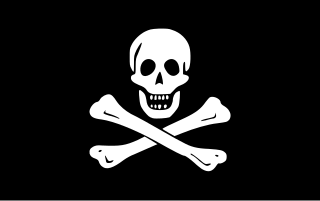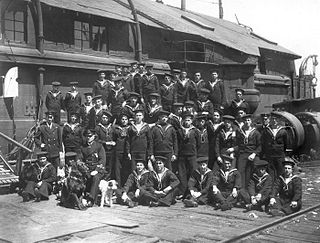
Newfoundland and Labrador is the easternmost province of Canada, in the country's Atlantic region. The province comprises the island of Newfoundland and the continental region of Labrador, having a total size of 405,212 square kilometres. In 2023, the population of Newfoundland and Labrador was estimated to be 533,710. The island of Newfoundland is home to around 94 per cent of the province's population, with more than half residing in the Avalon Peninsula. Labrador borders the province of Quebec, and the French overseas collectivity of Saint Pierre and Miquelon lies about 20 km (12 mi) west of the Burin Peninsula.

Piracy is an act of robbery or criminal violence by ship or boat-borne attackers upon another ship or a coastal area, typically with the goal of stealing cargo and other valuable goods. Those who conduct acts of piracy are called pirates, vessels used for piracy are pirate ships. The earliest documented instances of piracy were in the 14th century BC, when the Sea Peoples, a group of ocean raiders, attacked the ships of the Aegean and Mediterranean civilisations. Narrow channels which funnel shipping into predictable routes have long created opportunities for piracy, as well as for privateering and commerce raiding.

A privateer is a private person or vessel which engages in maritime warfare under a commission of war. Since robbery under arms was a common aspect of seaborne trade, until the early 19th century all merchant ships carried arms. A sovereign or delegated authority issued commissions, also referred to as letters of marque, during wartime. The commission empowered the holder to carry on all forms of hostility permissible at sea by the usages of war. This included attacking foreign vessels and taking them as prizes and taking crews prisoner for exchange. Captured ships were subject to condemnation and sale under prize law, with the proceeds divided by percentage between the privateer's sponsors, shipowners, captains and crew. A percentage share usually went to the issuer of the commission.

The United States Merchant Marine is an organization composed of United States civilian mariners and U.S. civilian and federally owned merchant vessels. Both the civilian mariners and the merchant vessels are managed by a combination of the government and private sectors, and engage in commerce or transportation of goods and services in and out of the navigable waters of the United States. The Merchant Marine primarily transports domestic and international cargo and passengers during peacetime, and operate and maintain deep-sea merchant ships, tugboats, towboats, ferries, dredges, excursion vessels, charter boats and other waterborne craft on the oceans, the Great Lakes, rivers, canals, harbors, and other waterways. In times of war, the Merchant Marine can be an auxiliary to the United States Navy, and can be called upon to deliver military personnel and materiel for the military.

The Barbary pirates, Barbary corsairs, or Ottoman corsairs were mainly Muslim pirates and privateers who operated from the Barbary states. This area was known in Europe as the Barbary Coast, in reference to the Berbers. Slaves in Barbary could be of many ethnicities, and of many different religions, such as Christian, Jewish, or Muslim. Their predation extended throughout the Mediterranean, south along West Africa's Atlantic seaboard and into the North Atlantic as far north as Iceland, but they primarily operated in the western Mediterranean. In addition to seizing merchant ships, they engaged in razzias, raids on European coastal towns and villages, mainly in Italy, France, Spain, and Portugal, but also in the British Isles, the Netherlands, and Iceland.

The destroyers-for-bases deal was an agreement between the United States and the United Kingdom on September 2, 1940, according to which 50 Caldwell, Wickes, and Clemson-class US Navy destroyers were transferred to the Royal Navy from the US Navy in exchange for land rights on British possessions.

The Blockade of Africa began in 1808 after the United Kingdom outlawed the Atlantic slave trade, making it illegal for British ships to transport slaves. The Royal Navy immediately established a presence off Africa to enforce the ban, called the West Africa Squadron. Although the ban initially applied only to British ships, Britain negotiated treaties with other countries to give the Royal Navy the right to intercept and search their ships for slaves.

Sir John Hawley Glover was a Royal Navy officer who served as Governor of Lagos Colony, Governor of Newfoundland, and Governor of British Leeward Islands.
The Maritime Archaic is a North American cultural complex of the Late Archaic along the coast of Newfoundland, the Canadian Maritimes and northern New England. The Maritime Archaic began in approximately 7000 BC and lasted until approximately 3500 BC, corresponding with the arrival of the Paleo-Eskimo groups who may have outcompeted the Maritime Archaic for resources. The culture consisted of sea-mammal hunters in the subarctic who used wooden boats. Maritime Archaic sites have been found as far south as Maine and as far north as Labrador. Their settlements included longhouses, and boat-topped temporary or seasonal houses. They engaged in long-distance trade, as shown by white chert from northern Labrador being found as far south as Maine.

HMS Trincomalee is a Royal Navy Leda-class sailing frigate built shortly after the end of the Napoleonic Wars. She is now restored as a museum ship afloat in the National Museum of the Royal Navy, Hartlepool, England.

The Golden Age of Piracy is a common designation for the period between the 1650s and the 1730s, when maritime piracy was a significant factor in the histories of the North Atlantic and Indian Oceans.

Maritime history is the study of human interaction with and activity at sea. It covers a broad thematic element of history that often uses a global approach, although national and regional histories remain predominant. As an academic subject, it often crosses the boundaries of standard disciplines, focusing on understanding humankind's various relationships to the oceans, seas, and major waterways of the globe. Nautical history records and interprets past events involving ships, shipping, navigation, and seafarers.

Andrew Lambert is a British naval historian, who since 2001 has been the Laughton Professor of Naval History in the Department of War Studies, King's College London.

Joseph Nicholson Barney was a career United States Navy officer (1835–1861) who served in the Confederate States Navy in the American Civil War (1861–1865).

The province of Newfoundland and Labrador covers the period from habitation by Archaic peoples thousands of years ago to the present day.
Admiralty House is a one-storey, wooden gable-roofed, municipally-designated heritage building originally built as a wireless communications station in Mount Pearl, Newfoundland and Labrador, Canada. It currently serves as a museum and archives. The building is purported to be the last standing of 11 such identical stations built around the world during the First World War.
The history of ships in North America and the maritime history of Colonial America has a strong foundation.

The Newfoundland Royal Naval Reserve was a military reserve force founded in 1900 in what was then the Newfoundland Colony, a part of the British Empire. From 1900 to 1902, approximately 50 members of the reserve trained each winter with the North American and West Indies squadron of the Royal Navy until a steam and sail powered training ship, HMS Calypso, was provided by the United Kingdom in 1902 for local drills before at-sea training with the NA and WI squadron. The reserve had 375 members by late 1903 and then between five and six hundred reservists until the start of World War I, growing to over 1000 in 1915. 1,964 Newfoundlanders served with the Naval Reserve in World War I, suffering 192 fatalities. The Reserve disbanded in 1920-1921. Calypso, having been renamed HMS Briton, was sold as a storage hulk and was burned for salvage near Lewisporte, Newfoundland and Labrador.

Cod fisheries are fisheries for cod. Cod is the common name for fish of the genus Gadus, belonging to the family Gadidae, and this article is confined to three species that belong to this genus: the Atlantic cod, the Pacific cod and the Greenland cod. Although there is a fourth species of the cod genus Gadus, Alaska pollock, it is commonly not called cod and therefore currently not covered here.

HMS Calypso was a corvette of the Royal Navy and the lead ship of its namesake class. Built for distant cruising in the heyday of the British Empire, the vessel served as a warship and training vessel until 1922, when it was sold.
















